A Study of the Effect of Heat-Treatment on the Morphology of Nafion Ionomer Dispersion for Use in the Passive Direct Methanol Fuel Cell (DMFC)
Abstract
:1. Introduction
2. Results and Discussions
2.1. NMR, Viscosity, and Membrane Ionic Conductivity Results
2.1.1. Nafion Ionomer Solutions
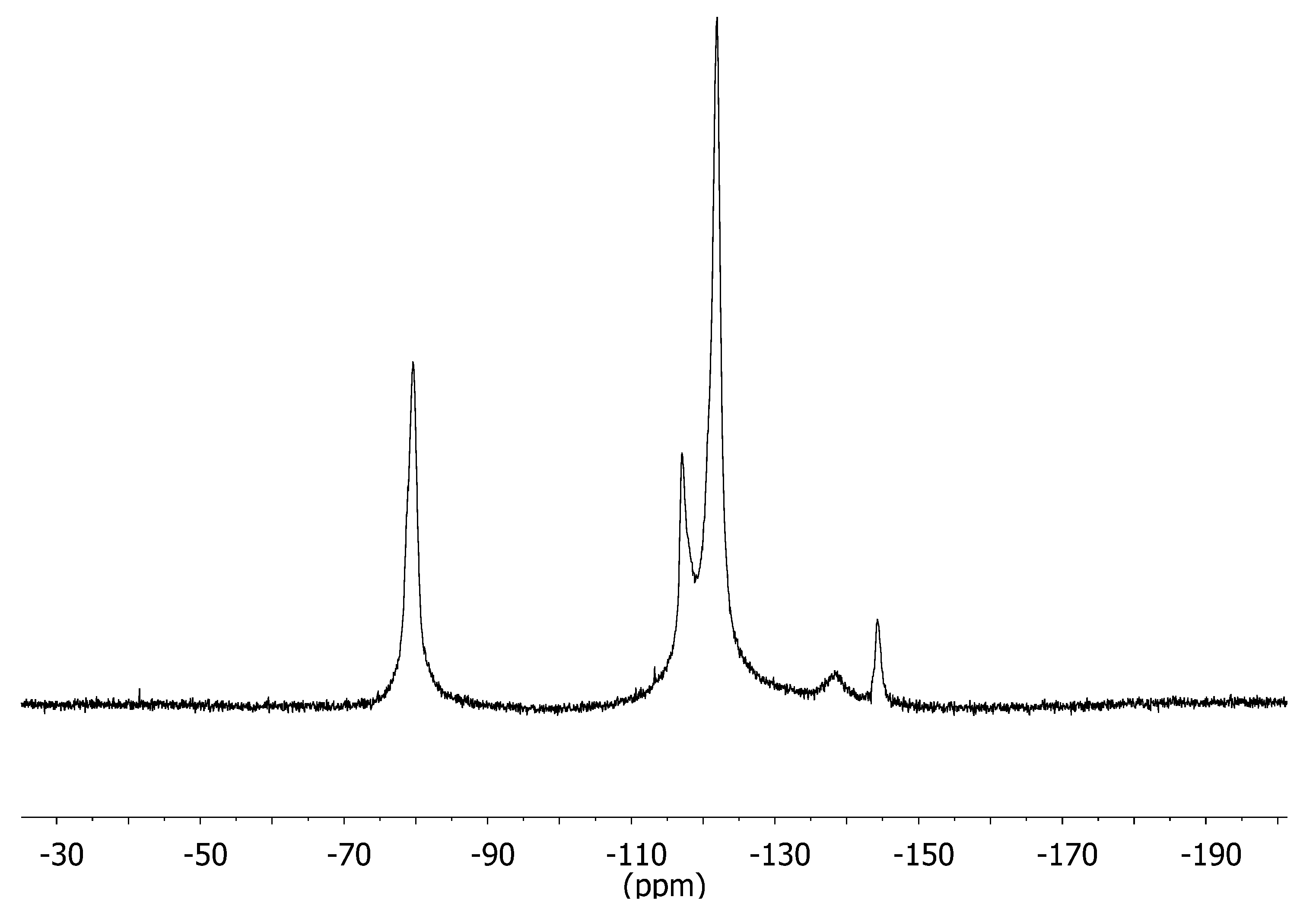
| Sample Name | Heat-Treatment Temperature (°C) | Nucleus (19F) | |||
|---|---|---|---|---|---|
| T1 (s) (±0.05) | D (×10−11 m2/s) (±0.1) | Viscosity η (×10−3 Pa s) | Radius (×10−9 m) | ||
| A | 25 | 0.92 | 3.2 | 1.9 | 3.6 |
| B | 50 | 0.89 | 3.6 | 2.2 | 2.8 |
| C | 80 | 0.90 | 4.4 | 2.4 | 2.1 |

2.1.2. Nafion 117 Membrane
| Sample Name | Heat-Treatment Temperature (°C) | Nucleus (1H) | |
|---|---|---|---|
| T1 (s) | Ionic Conductivity (S/cm) | ||
| Nafion 117 membrane (ref.) | – | 0.22 | 0.062 |
| A | 25 | 0.25 | 0.079 |
| B | 50 | 0.20 | 0.079 |
| C | 80 | 0.20 | 0.077 |
2.2. The Distribution of Aggregates in the Catalytic Ink and Catalyst Layer
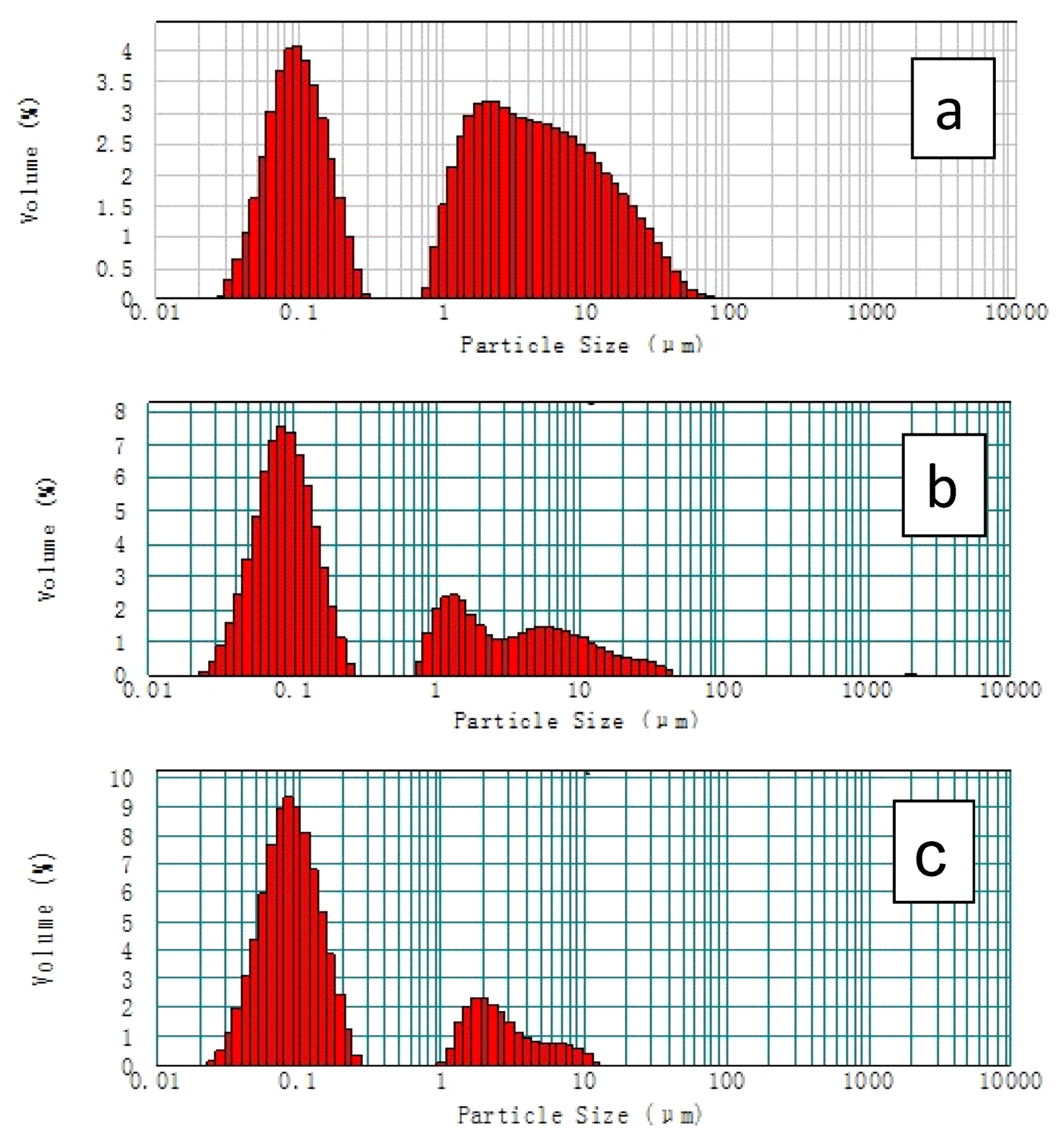
| Pretreated temperature (°C) | Ratio of small particles | ECSAH (m2 g−1) | ECSAco (m2 g−1) | I (0.85V) (mA cm−2) | MP (mW cm−2) |
|---|---|---|---|---|---|
| 25 | 36.7% | 29.1 | 52.7 | 0.86 | 31.7 |
| 50 | 65.5% | 39.1 | 58.2 | 1.09 | 34.4 |
| 80 | 79.9% | 51.3 | 63.7 | 1.45 | 39.8 |

2.3. Electrochemistry and Electrocatalysis of Pt/C Catalytic Electrode with Tuned Aggregates Size for the Oxygen Reduction
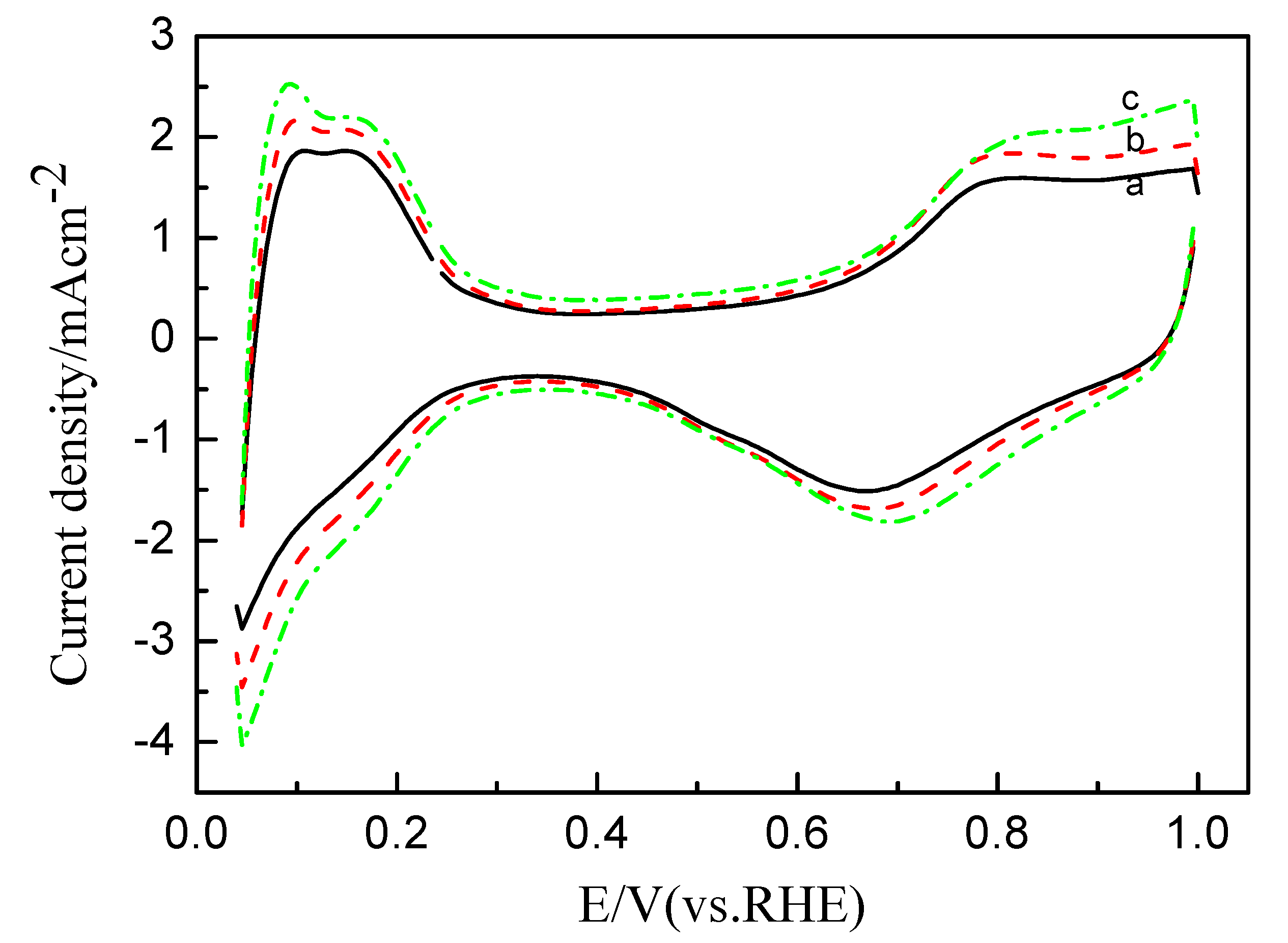
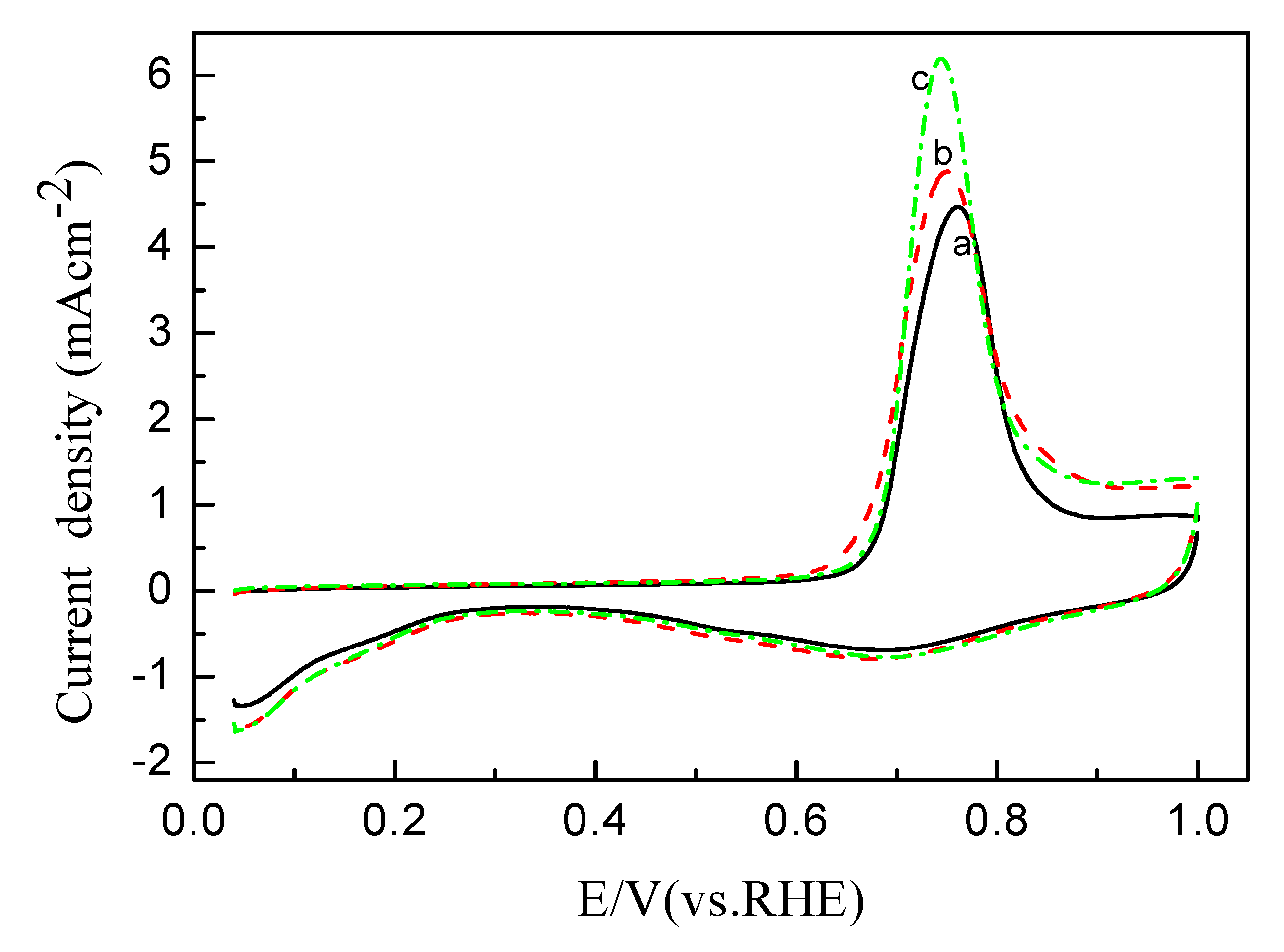
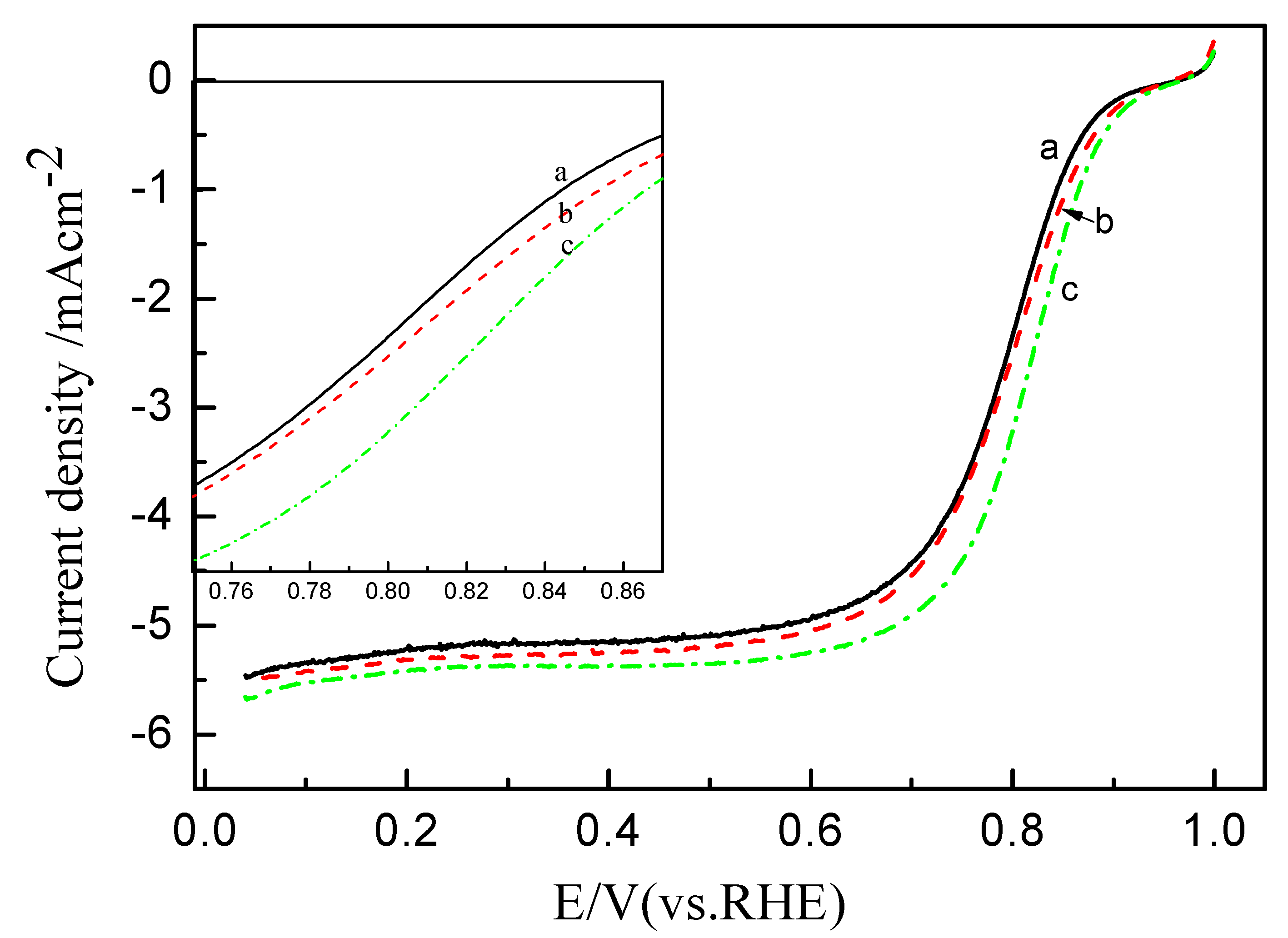
2.4. Performance Comparison of the Passive DMFCs with Cathode Catalyst Ink Pre-Heated at Various Temperatures
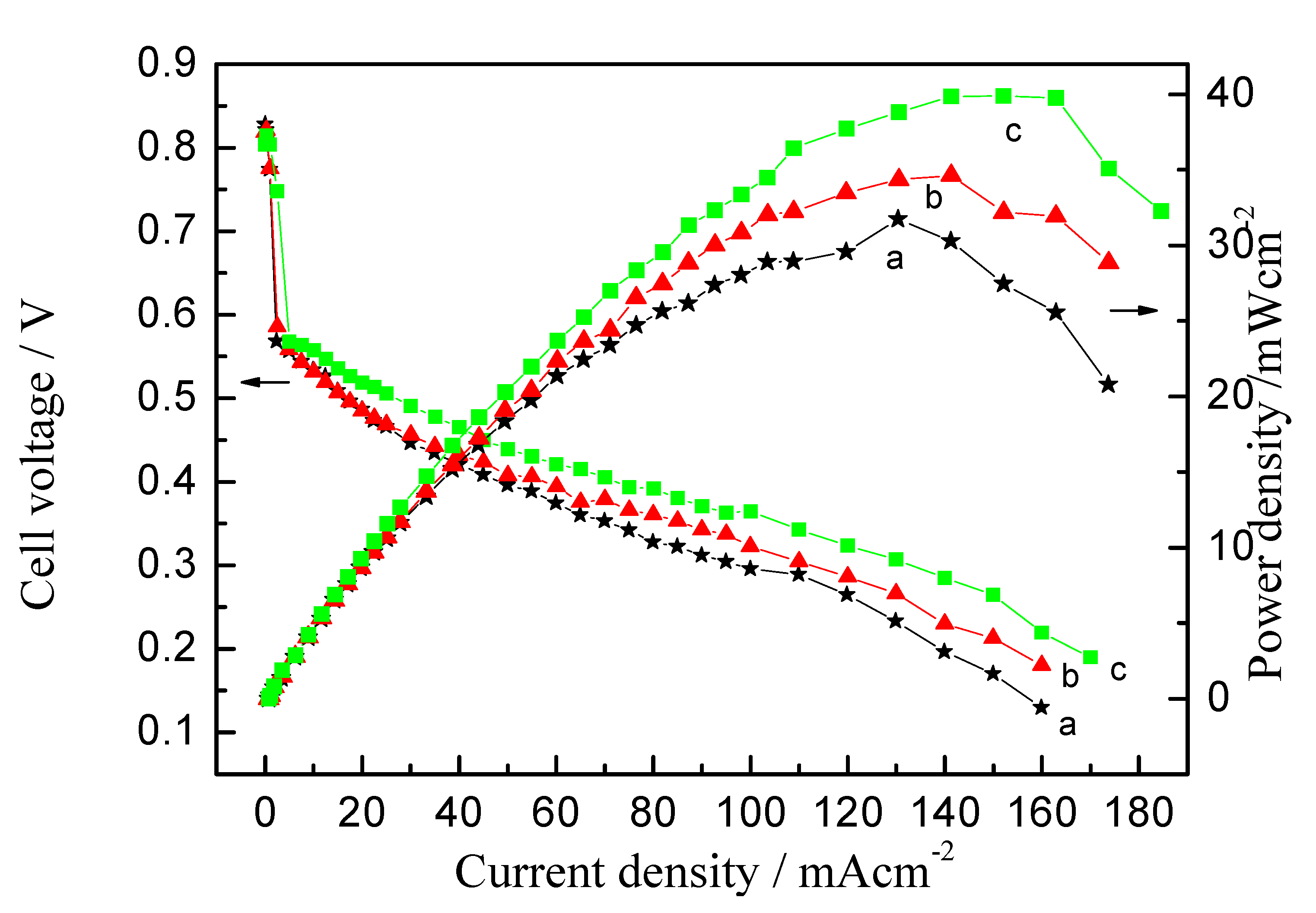
3. Experimental
3.1. NMR, Viscosity and IS Measurements of Nafion 117 Membrane and Ionomer Solutions

3.2. Measurement of Nafion Aggregation in Catalyst Ink
3.3. Characterization of Cathode Catalyst Layer
3.4. Electrochemical Characterizations of Cathode Catalyst Layers
3.5. Single Cell Test
4. Conclusions
Acknowledgements
References
- Kamarudin, S.K.; Achmad, F.; Daud, W.R.W. Overview on the application of direct methanol fuel cell (DMFC) for portable electronic devices. Int. J. Hydrog. Energy 2009, 34, 6902–6916. [Google Scholar] [CrossRef]
- Kamarudin, S.K.; Daud, W.R.W.; Ho, S.L.; Hasran, U.A. Overview on the challenges and developments of micro-direct methanol fuel cells (DMFC). J. Power Sources 2007, 163, 743–754. [Google Scholar] [CrossRef]
- Kim, D.J.; Cho, E.A.; Hong, S.-A.; Oh, I.-H.; Ha, H.-Y. Recent progress in passive direct methanol fuel cells at KIST. J. Power Sources 2004, 130, 172–177. [Google Scholar] [CrossRef]
- Zhao, T.S.; Chen, R.; Yang, W.W.; Xu, C. Small direct methanol fuel cells with passive supply of reactants. J. Power Sources 2009, 191, 185–202. [Google Scholar] [CrossRef]
- Basri, S.; Kamarudin, S.K.; Daud, W.R.W.; Yaakub, Z. Nanocatalyst for direct methanol fuel cell (DMFC). Int. J. Hydrog. Energy 2010, 35, 7957–7970. [Google Scholar] [CrossRef]
- Luo, Y.L.; Liang, Z.X.; Liao, S.J. Recent development of anode electrocatalysts for direct methanol fuel cells. Chin. J. Catal. 2010, 31, 141–149. [Google Scholar]
- Zainoodin, A.M.; Kamarudin, S.K.; Daud, W.R.W. Electrode in direct methanol fuel cells. Int. J. Hydrog. Energy 2010, 35, 4606–4621. [Google Scholar] [CrossRef]
- McGovern, M.; Garnett, E.C.; Rice, C.; Masel, R.I.; Wieckowski, A. Effects of Nafion as a binding agent for unsupported nanoparticle catalysts. J. Power Sources 2003, 115, 35–39. [Google Scholar] [CrossRef]
- Aricò, A.S.; Creti, P.; Antonucci, P.L.; Cho, J.; Kim, H.; Antonucci, V. Optimization of operating parameters of a direct methanol fuel cell and physico-chemical investigation of catalyst-electrolyte interface. Electrochim. Acta 1998, 43, 3719–3729. [Google Scholar] [CrossRef]
- Szajdzinska-Pietek, E.; Schlick, S.; Plonka, A. Self-assembling of perfluorinated polymeric surfactants in nonaqueous solvents. Electron spin resonance spectra of nitroxide spin probes in nafion solutions and swollen membranes. Langmuir 1994, 10, 2188–2196. [Google Scholar] [CrossRef]
- Xie, Z.; Navessin, T.; Zhao, X.; Adachi, M.; Holdcroft, S.; Mashio, T.; Ohma, A.; Shinohora, K. Nafion ionomer aggregation and its influence on proton conduction and mass transport in fuel cell catalyst layers. In Proton Exchange Membrane Fuel Cells 8, Pts 1 and 2, Proceedings of the 214th ECS Meeting, Honolulu, HI, USA, 12–17 October, 2008; Fuller, T., Shinohara, K., Ramani, V., Shirvanian, P., Uchida, H., Cleghorn, S., Inaba, M., Mitsushima, S., Strasser, P., Nakagawa, H., Gasteiger, H., Zawodzinski, T., Lamy, C., Eds.; Electrochemical Society: Pennington, NJ, USA, 2008; 16, pp. 1811–1816. [Google Scholar]
- Wang, S.; Sun, G.; Wu, Z.; Xin, Q. Effect of Nafionionomer aggregation on the structure of the cathode catalyst layer of a DMFC. J. Power Sources 2007, 165, 128–133. [Google Scholar] [CrossRef]
- Wu, P.; Li, B.H.; Du, H.D.; Gan, L.; Kang, F.Y.; Zeng, Y.Q. The influences of multi-walled carbon nanotube addition to the anode on the performance of direct methanol fuel cells. J. Power Sources 2008, 184, 381–384. [Google Scholar] [CrossRef]
- Kang, Y.Y.; Ren, M.J.; Yuan, T.; Qiao, Y.J.; Zou, Z.Q.; Yang, H. Effect of Nafion aggregation in the anode catalytic layer on the performance of a direct formic acid fuel cell. J. Power Sources 2010, 195, 2649–2652. [Google Scholar]
- Kang, Y.Y.; Ren, M.J.; Zou, Z.Q.; Huang, Q.H.; Li, Z.L.; Atkins, D.L.; Yang, H. Improved electrocatalytic performance of Pd nanoparticles with size-controlled Nafion aggregates for formic acid oxidation. Electrochim. Acta 2010, 55, 5274–5280. [Google Scholar] [CrossRef]
- Yuan, T.; Yang, H.; Kang, Y.; Chen, J.; Qiao, Y.; Xue, X.; Zou, Z.; Yang, H. Enhanced performance of a passive direct methanol fuel cell with decreased Nafion aggregate size within the anode catalytic layer. Int. J. Hydrog. Energy 2011, 36, 10000–10005. [Google Scholar] [CrossRef]
- Chen, Q.; Schmidt-Rohr, K. 19F and 13C NMR signal assignment and analysis in a perfluorinatedionomer (Nafion) by two-dimensional solid state NMR. Macromolecules 2004, 37, 5995–6003. [Google Scholar] [CrossRef]
- Lee, S.-J.; Yu, T.L.; Lin, H.-L.; Liu, W.-H.; Lai, C.-L. Solution properties of Nafion in methanol/water mixture solvent. Polymers 2004, 45, 2853–2862. [Google Scholar]
- Snyder, J.D.; Elabd, Y.A. Nafionnanofibers and their effect on polymer electrolyte membrane fuel cell performance. J. Power Sources 2009, 186, 385–392. [Google Scholar] [CrossRef]
- He, W.; Chen, M.; Zou, Z.; Li, Z.; Zhang, X.; Jin, S.-A.; You, D.J.; Pak, C.; Yang, H. Oxygen reduction on Pd3Pt1 bimetallic nanoparticles highly loaded on different carbon supports. Appl. Catal. B Environ. 2010, 97, 347–353. [Google Scholar] [CrossRef]
- Suarez, S.; Greenbaum, S.G.; Fontanella, J.; Zawodzinski, T. A fundamental study of the transport properties of aqueous superacid solutions. J. Phys. Chem. B 2010, 114, 8941–8947. [Google Scholar] [CrossRef]
- Yuan, T.; Zou, Z.; Chen, M.; Li, Z.; Xia, B.; Yang, H. New anodic diffusive layer for passive micro-direct methanol fuel cell. J. Power Sources 2009, 192, 423–428. [Google Scholar] [CrossRef]
© 2012 by the authors; licensee MDPI, Basel, Switzerland. This article is an open access article distributed under the terms and conditions of the Creative Commons Attribution license (http://creativecommons.org/licenses/by/3.0/).
Share and Cite
Yuan, T.; Zhang, H.; Zou, Z.; Khatun, S.; Akins, D.; Adam, Y.; Suarez, S. A Study of the Effect of Heat-Treatment on the Morphology of Nafion Ionomer Dispersion for Use in the Passive Direct Methanol Fuel Cell (DMFC). Membranes 2012, 2, 841-854. https://doi.org/10.3390/membranes2040841
Yuan T, Zhang H, Zou Z, Khatun S, Akins D, Adam Y, Suarez S. A Study of the Effect of Heat-Treatment on the Morphology of Nafion Ionomer Dispersion for Use in the Passive Direct Methanol Fuel Cell (DMFC). Membranes. 2012; 2(4):841-854. https://doi.org/10.3390/membranes2040841
Chicago/Turabian StyleYuan, Ting, Haifeng Zhang, Zhiqing Zou, Sufia Khatun, Daniel Akins, Yara Adam, and Sophia Suarez. 2012. "A Study of the Effect of Heat-Treatment on the Morphology of Nafion Ionomer Dispersion for Use in the Passive Direct Methanol Fuel Cell (DMFC)" Membranes 2, no. 4: 841-854. https://doi.org/10.3390/membranes2040841





